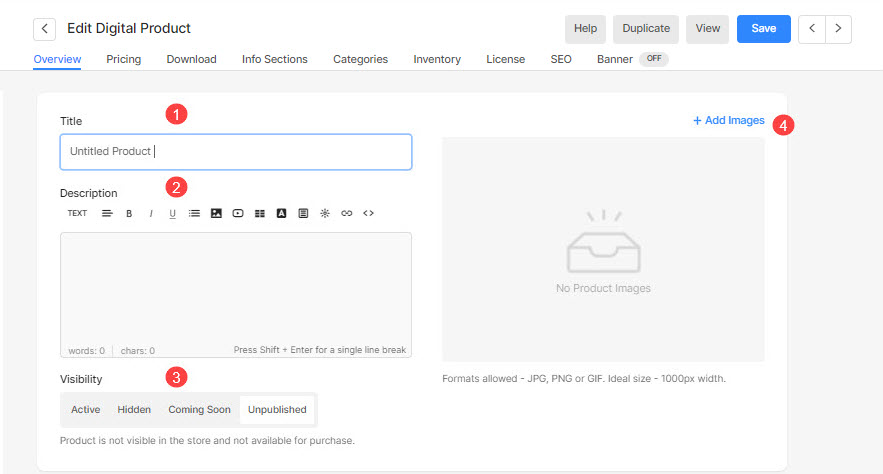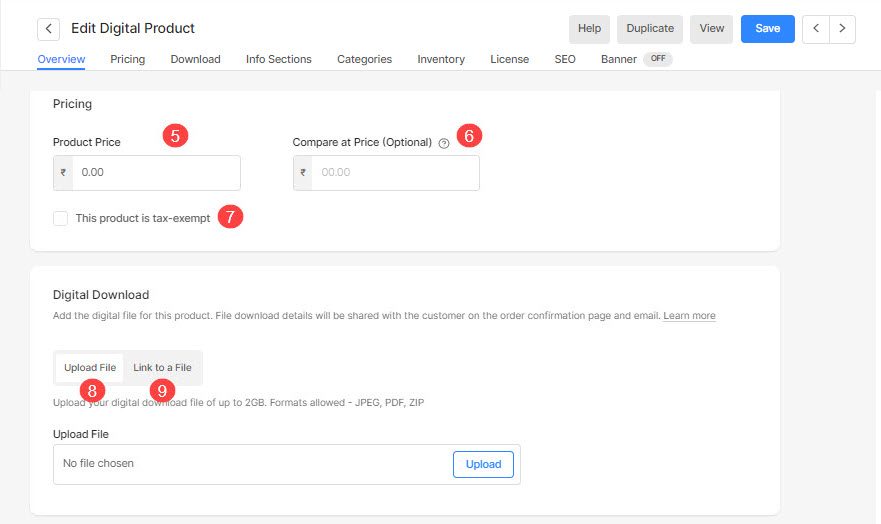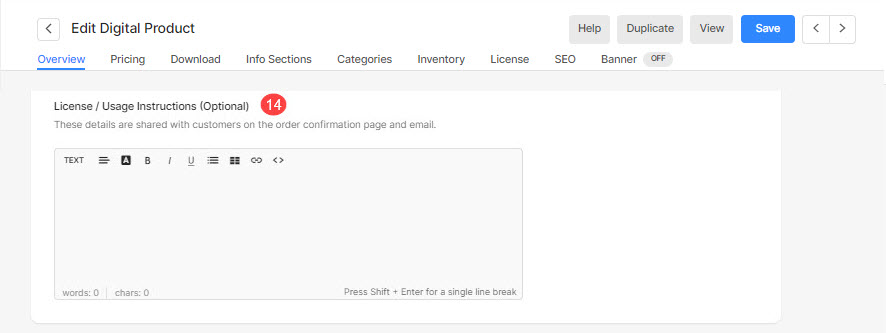Digital product refers to digital goods or content, such as graphics, software, e-books, music, etc. These products are typically delivered electronically, allowing customers to download them directly to their devices after purchase, without the need for physical shipment.
Once you have enabled the store, you can add digital products to it.
In this article:
- Add a Digital Product
- Overview
- Pricing
- Info Section
- Related Products
- Store Listing
- Inventory
- SEO Options
- Checkout Process for Digital Product
Add a Digital Product
- Enter Store products (1) in the Search Bar.
- From the related results, click on the Store products option (2) under Studio Links.

- You will now reach the Products page.
- Click on the + Add Product (3) button at the top right side of the screen. This opens a dropdown that lets you choose the product type that you want to add.
- Click on the Digital Download (4) option.

This will take you to the product creation/edit page. See the screenshots and directions below:
- Title: The name of your product.
- Description: Product description supports rich text and HTML so you can even embed a product video in the description if you want to.
- Visibility: Products can have 4 states (Active / Hidden / Coming Soon / Unpublished).
Also See: Set store product status. - Images: Add up to 200 images for your product. You can drag and drop images to sequence them after you have added the images and saved the product. The first image in the sequence is taken as the default image for the product.
Also Check: How many images can I add to a product?
Preparing your images – Image size
Ideally, images should be JPEGs and around 1000 pixels in width.

Pricing
- Product price: The default price of the base variant of your product. It is shown on the product listing page.
- Compare at price: Optional value to put your products on sale. Compare at price is the un-discounted price of the product and should always be more than the product price.
- This product is tax-exempt: Check in this option to exempt tax on a particular product.
- Upload File: You can upload your digital assets (sound, images, audio, zip file, etc) up to a size of 2 GB. Click on the Upload button to select the files in Add digital file.
- Link to a File: You can also add your external file link to share its link with your buyers/users.

Info Section
Info sections are useful to show more content in addition to the product description that can be applied to multiple products at once. Learn more about Info sections.
Related Products
This is the section that typically displays items that are complementary or similar to the product a customer is currently viewing, encouraging additional purchases and enhancing the shopping experience.
While adding / editing a product, you can customize the products that will be displayed as its related product.
- Show Products: From here, you can select one of the following four options:
- All Products: With this option, all the products of store that are published will be listed as related products.
- Based on Category: Using this option, you can display the related products based on a Category.
- Based on Tag: Using this option, you can display the related products based on a tag.
- None: This will disable the “Related Products” section for the particular product that is currently being added / edited.
- Select Category / Tag: This option will be displayed according to the selection made in the previous step. If you have selected “Based on Category”, you can select a particular category or all categories. Similarly, if “Based on Tag” option is selected, you can choose a particular tag or all the tags.

Store Listing
- Categories: Select the category from the list to add this product to that particular category.
- Tags: Add tags to a product to assign them to a category. Tags can also be used to filter products.
Also Check: What are Tags? How to use tags in products and categories?

Inventory
- Manage Inventory: Manage the quantity of a particular digital product that is available for sale in your Pixpa store.
Also Check: Manage inventory for store products. - SKU: Add the stock-keeping unit here, if any.

- License/Usage instructions: Include the license/usage instructions for this particular product here.

Search Engine Optimization
- SEO data – Specify SEO metadata for this particular product. It will override the website’s main SEO data.
Also Check: Add SEO metadata for your website, gallery, and page.- Page URL – Manage the URL for this product. The URL slug is automatically generated using your product title. But you can customize it as well.
- Page Title –
- Page Description –
- Hide this page from search engines – Hide this product from the search engine by selecting this option.
- Google Search Results Preview (5) shows you the SEO data as visible in case of search results.

- Page Code Injection: Insert any external code that will be added to the body section of a product page.
- Delete Product – Used to delete this product.
- Duplicate the existing product.
- After saving, click on the View button to check the live product on your website.
- Click on the Save button to save the product.

Checkout Process for Digital Product
- After placing the order successfully, the customer will see the order success/thank you page.
- Customers can directly download the digital assets from the order page, only if the order is prepaid (i.e. those orders which are processed by PayPal, PayUMoney, or Stripe payment gateway)
- And if the order is processed by offline payments, then the customer would not be able to download the digital assets until you confirm the payment and set the order status as paid on the Orders page.
- Once you receive the order amount, click on the particular order which you want to mark as paid
- Follow the image below to update from unpaid to paid in just 2 steps, click on Update Order Status (1) and then on the Change Order Status (2) button.
- We’ll send an email to your customer regarding the order update. If you don’t want to notify them, simply uncheck the Notify customer by email (3) option.

